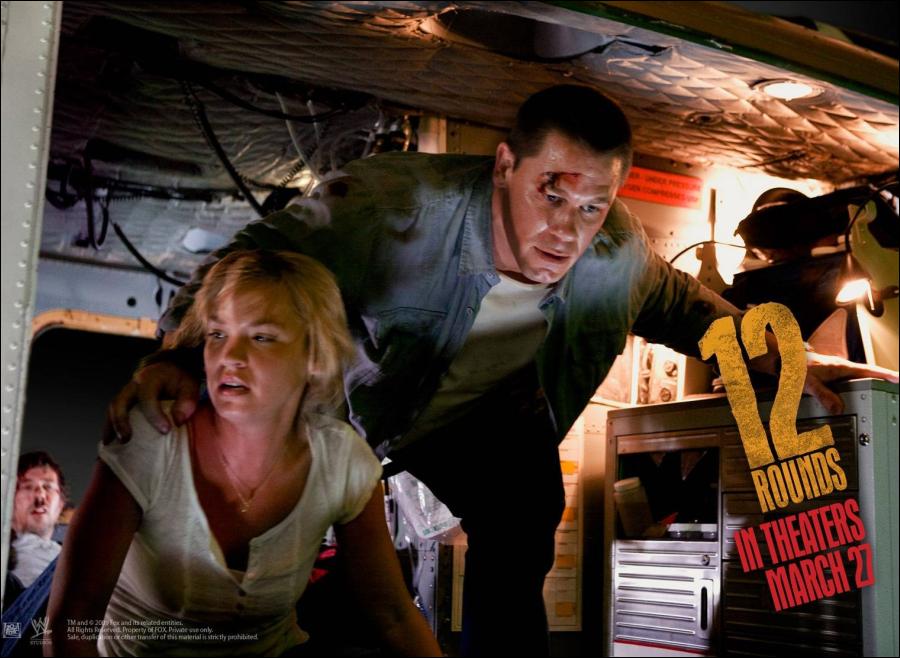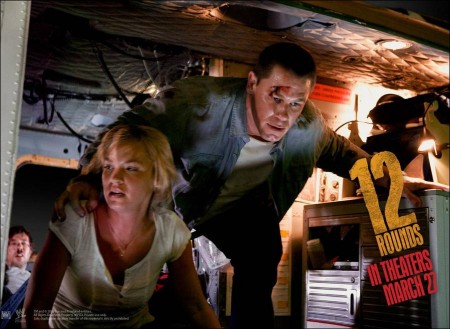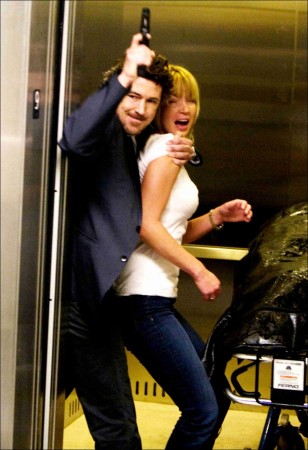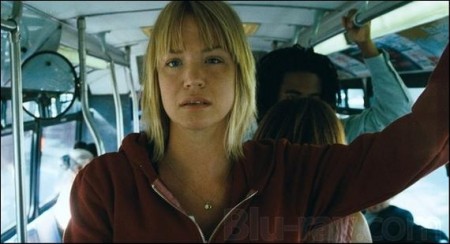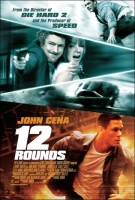About the Production
For John Cena, 12 ROUNDS is more than another role; it’s his initiation into the rarified air of action movie star. Moreover, the film’s Danny Fisher is the type of action hero that Cena enjoyed watching, as a fan of the genre. “The ’80s was the era of the ‘everyman’ hero,” Cena explains.
“And there hasn’t been that style of hero since then. Guys like Bruce Willis in ‘Die Hard’ proved that an everyday person can be an action hero. If I’m even considered in that club, I’m definitely off to a great start.”
For his legions of fans, bigger-than-life wrestling superstar Cena might be an unusual choice to play a “regular” guy, in this case a New Orleans cop struggling to save his kidnapped girlfriend from a revenge-seeking criminal. But 12 ROUNDS’ Danny Fisher’s relatability was a key attraction to Cena. “The whole everyman thing is easy, I’m just trying to be me,” he says. “I like the fact that Danny struggles. He doesn’t come out of a phone booth and stop bullets. When audiences see 12 ROUNDS and see Danny in action, I think every man, woman and child in the theater can go, ‘You know what, that’s possible, and under the right circumstances, I can pull that off.'”
“Danny likes being a cop, but he’s not a super-cop,” says producer Josh McLaughlin of The Mark Gordon Company. “When he’s confronted by someone who threatens someone Danny loves, he will not stop until he solves the problem.”
WWE Films president, Michael Lake notes that 12 ROUNDS “plays to Cena’s physical gifts, as well as, his natural acting ability. He’s a throwback to a different era of action films, when guys like McQueen and Stallone muscled their way through scenes. It made movies more believable, and more thrilling for the audience.” Echoes director Renny Harlin: “The best action heroes are the ones the audience can relate to and cheer for, but still feel like these guys experience pain, have a sense of humor, and are real. There’s a hunger now for this kind reality-based, high-octane action movie.”
Cena’s involvement with 12 ROUNDS began when the script was still very much a work in progress. McLaughlin got a call from Cena’s agent for a meet-and-greet. After a few minutes, they were chatting like old friends. “I thought, ‘Boy, this guy’s got something,'” McLaughlin recalls. “On top of being really charismatic, he was Danny.”
Producer Mark Gordon was similarly impressed. “We saw in John the potential to become the next big action star. 12 ROUNDS can really change his career and take him to the next level of international movie stardom.”
Earlier, McLaughlin and first-time screenwriter Daniel Kunka began the task of trying to reinvent the action film genre for today’s audiences. “We wondered how to make a movie that is that sort of contained, high-concept, idea,” says McLaughlin. “The answer, we thought, was to make it as plausible as possible. Then, Daniel came up with the idea about a guy who has to keep doing these tasks that were both Herculean and real.”
“That was a hook that we thought audiences hadn’t seen before,” adds Kunka. During this fateful meeting with McLaughlin, Kunka remembers “scribbling the words 12 ROUNDS on a piece of paper,” and the script took on a life of its own. “The script was so tight – it was all action,” says Harlin. “Even the dialogue is spoken on the run. There’s never a moment’s rest.”
Working with talented new screenwriters was nothing new for producer Mark Gordon, who memorably collaborated with then unknown scripter Graham Yost on “Speed,” which became a touchstone for contemporary action films. “I’m very comfortable with that process to get the best possible work from talented writers,” says Gordon, whose many other credits include “The Day After Tomorrow” and “Saving Private Ryan.”
In true Hollywood storybook fashion, Kunka’s fortunes turned around overnight. “I was getting a sandwich and had about eight hundred dollars in my bank account, and was contemplating quitting the business,” he remembers. “And then one day I got a call [from the producers], telling me, ‘John Cena and WWE Films want to make your movie.'”
With Cena onboard and a green light from WWE Films, all that was needed was a director who could capture the frenetic nature of the script – a contemporary action auteur with an appetite for harrowing realism. Enter, veteran action director Renny Harlin, whose work on “Die Hard 2” and “Cliffhanger” has made him the avatar of adrenaline fueled films. Harlin’s deft sense of tempo, pace, and narrative momentum made him “the perfect director for the job” explains Lake. But it was a lively pitch meeting with Gordon, Lake and McLaughlin that sealed the deal. “Renny brought this energy to the script and to the movie. He wanted it to be just nonstop, have the pace continue,” adds Lake.
To Harlin, the film was an opportunity to reinvent the genre. “I’d like to think of 12 ROUNDS as a movie that started a new style of action movies, the sort of ‘Docu-Realism’ commando style shooting of action movies, instead of super-polished, glossy, Hollywood-fantasy fare. We gave the film a real down and dirty feel, which better reflects the tenor of pop culture.”
For 12 ROUNDS’ thrilling action sequences, Harlin wanted to break with the traditional style of filmmaking associated with his earlier films. “I wanted this film to have a visual style that complemented John’s athleticism. Instead of portraying him as a superhero, we’ve made him an everyman,” Harlin explains. “I’ve thrown out all the usual tools – fancy dolly shots, cranes and CGI effects – that people expect from a contemporary action movie. Think of 12 ROUNDS as a real story that’s really happening, and what we’ve just done is taken three documentary crews and thrown them out there and let them start chasing these actors and get the story on film.
“I told the actors, starting with John Cena, that this is not like the usual Hollywood way of making films, where you rehearse a scene, and then you mark with tape everybody’s steps on the ground, and where they deliver their lines, and how they turn this way and that way,” Harlin continues. “I said, ‘We might rehearse it, but we’re going to basically just shoot it, and you guys have freedom to do whatever you want to do. Just go, just live it, just make it real. And don’t worry about the camera, don’t worry about the light hitting you, or the microphone being in the right place. We’re going to get the shots as if we were in a combat zone.”
The guerilla-style filmmaking included mixing different media and cameras, including mini-DV cameras and even camera-phones. “We employed different ways of telling the story visually, including video surveillance footage and aerial footage,” says director of photography David Boyd. “We packed it all in to make 12 ROUNDS relentless and gritty, from beginning to end.”
Harlin’s quest for authenticity was infectious on the set. Throughout production, Cena volunteered to do many of his own stunts, including racing cars, running the equivalent of several 10K races, crashing a fire truck, and simulating a gunfight; that latter had him training with the New Orleans Police Department. “The training officer literally put him through the entire course that qualifies you for SWAT,” stunt coordinator Steve Ritzi says, marveling at Cena’s gun handling ability. “John scored such high marks that he could’ve joined the Force if he wanted to.”
But when stunt work meant confronting his phobias, Cena had second thoughts. “I have a fear of heights – an undying, palm-sweaty fear,” he sheepishly admits. Asked to rappel 100 feet down the side of building – wearing a harness and tethered only by a thin wire, Cena told Harlin, “This is an historic moment. It may not make front pages of anywhere, but you’re the last director, the last person for that matter, that will ever get me to do something like that again. I was that scared.”
In a very “Danny-esque” moment, Cena overcame his concerns, literally swinging into action for the rappelling stunt, completing all the shots in one day. Ritzi remembers the big event. “After the first day, I told John [Cena], ‘You’re done in the harness, you don’t have to hang on the side of the building anymore. I mean, he was out there a lot. He was very relieved.
“Well, the first thing next day, Renny hands me the shot list. He wants to get John [for more shots] on the side of the building, and I said, ‘I’ve already told John he doesn’t have to go back on the harness,’ and we just kind laughed about it. I said, ‘I’m not going to be the one who has to tell him he has to get back on the harness.’ So, Renny says, ‘That’s fine, I’ll tell him.'”
To play the villainous Miles, the filmmakers cast Aiden Gillen. Trained on the stage, Gillen had recently received acclaim for his work in HBO’s “The Wire,” as the duplicitous Mayor Thomas Carcetti. “Aidan feels smarter than us. When he plays Miles, he feels like someone who simply could sit in a room with you and tell you everything that’s wrong with you in five minutes,” says McLaughlin. “And I think that’s what makes for a good villain, a guy who seems like he’s in control of the situation – even if a gun is pointed at his head.”
The fact that Cena is significantly taller and bigger than Gillen didn’t diminish Gillen’s/Miles’ power and sense of control. “I didn’t think about the disparity in size,” says Gillen. “Miles has his own kind of slick and lethal moves that challenge Danny in the film’s climax.” Adds Renny Harlin: “Aiden plays Miles with a delicious attention to detail and with colorful nuances. He makes it a very powerful character. You could put John and Aiden next to each other and think John could kill him with one punch. But it’s not always about that in real life, and I think that difference [in height and size] between them really plays well in the film.”
Matching Gillen’s intensity is Danny’s strong willed girlfriend, Molly, portrayed by Ashley Scott. A native of Charleston, S.C., but actually born in New Orleans, Scott had a starring role in the cult series “Jericho” and featured roles in the action films “Into the Blue” and “Walking Tall.” 12 ROUNDS’ Molly is a hospital Medevac helicopter pilot, a job that figures prominently in the film’s explosive climax. Scott, who learned how to fly a helicopter for the film, notes that she also gave Molly a backstory. “I imagined she was trained in the Air Force. She had been on her own for a while, until she met Danny.”
Rounding out the starring cast are Emmy nominated actor Steve Harris as Aiken, an FBI agent who has been trailing Miles for years and has a personal score to settle with him. Aiken is the mirror image of Danny – both will stop at nothing to get Miles. “They start out as enemies,” says Harris, “then they begin to work together and understand each other. It’s a nice dynamic. Brian White (“Stomp the Yard,” TV’s “The Shield”) portrays Danny’s partner, Hank. “Hank is more than Danny’s partner,” notes White. “He’s his best friend and right arm. He’s there for Danny, no matter what the challenge or danger.”
Daniel Kunka’s early script drafts were set in Chicago, but producer Michael Lake had another city in mind – New Orleans – for both creative and economic reasons. Consequently, Lake and Kunka flew to The Big Easy to scout locations, and Kunka rewrote the script to reflect the new locale. “You’ll see more of New Orleans in the picture than in any other movie that was shot here,” says Lake. “The city is part of the fabric of the film. We see the Ninth Ward, the French Quarter, the Central Business District, and Algiers.” Adds Harlin: “New Orleans has an exotic tropical feel that no other city in America has.”
But fresh in everyone’s mind was the devastation of Hurricane Katrina. Evidence of the cataclysmic storm was still very much apparent. “It was obvious to us that something of biblical proportions happened here, but everybody here has been rebuilding and trying to get their lives back together,” says Ashley Scott. “We have met some really special people and heard some really special stories.”
Production notes provided by 20th Century Fox.
12 Rounds
Starring: John Cena, Steve Harris, Aidan Gillen, Brian White, Gonzalo Menendez, Ashley Scott
Directed by: Renny Harlin
Screenplay by: Daniel Kunka
Release Date: March 27, 2009
MPAA Rating: PG-13 for intense sequences of violence and action, brief strong language, smoking and a scene of teen drinking.
Studio: 20th Century Fox
Box Office Totals
Domestic: $11,378,489 (79.2%)
Foreign: $2,997,387 (20.9%)
Total: $14,375,876 (Worldwide)
